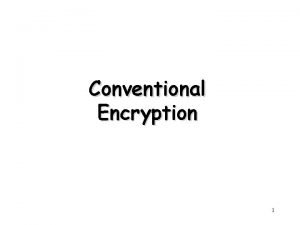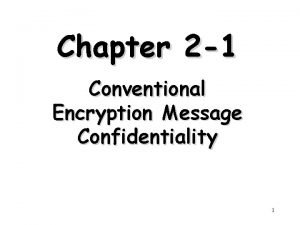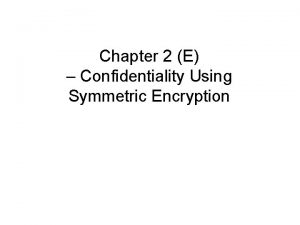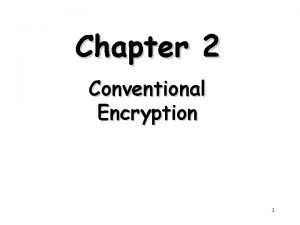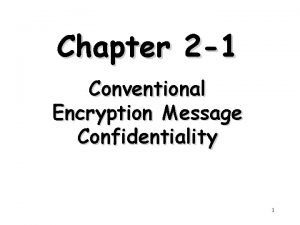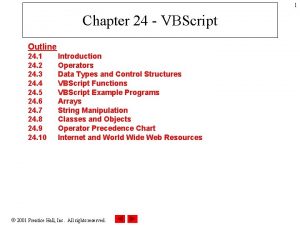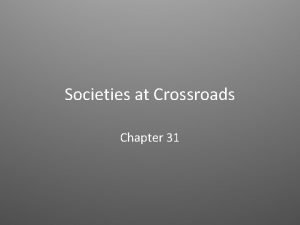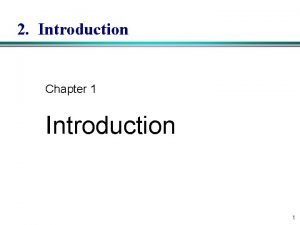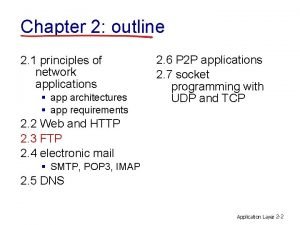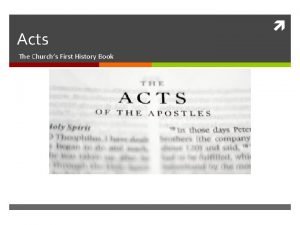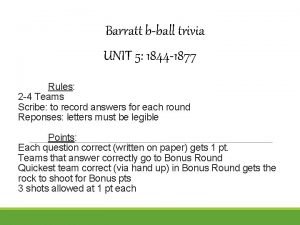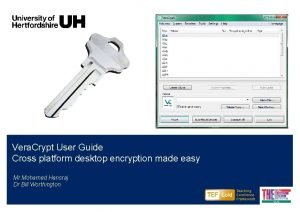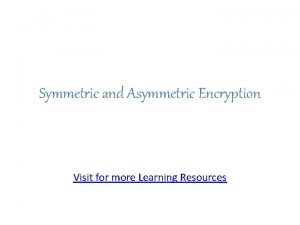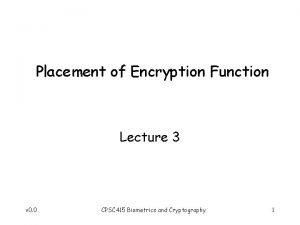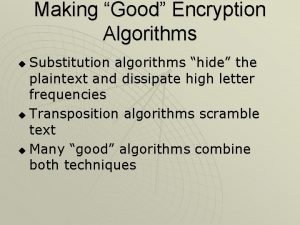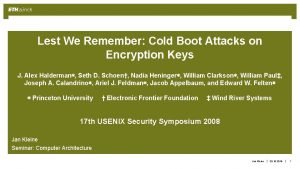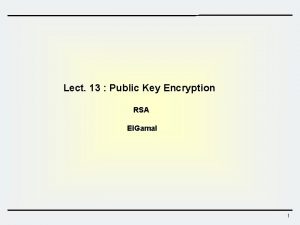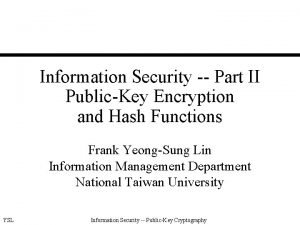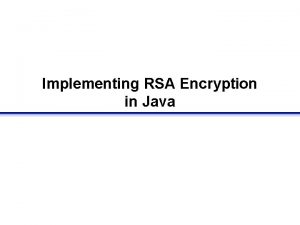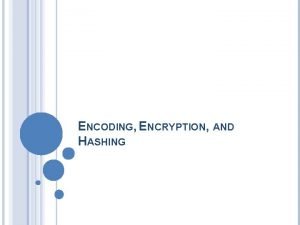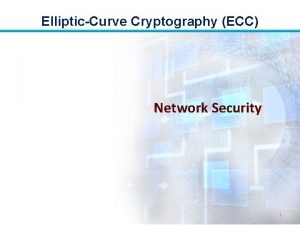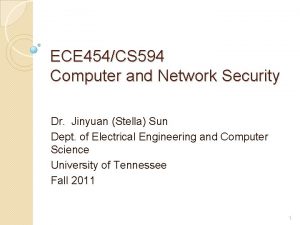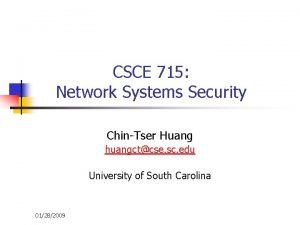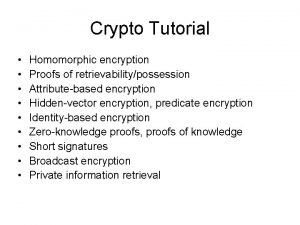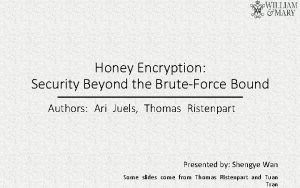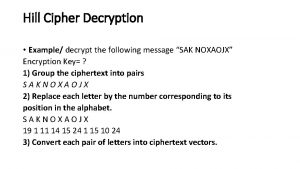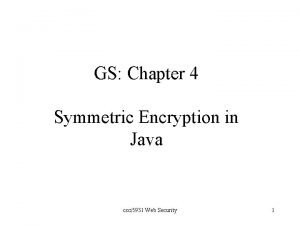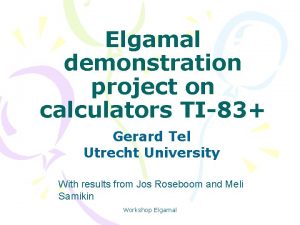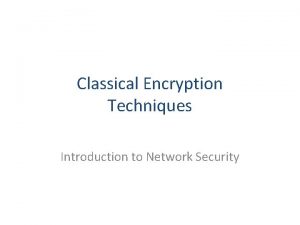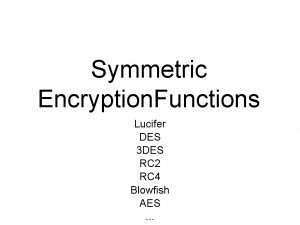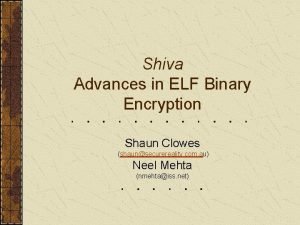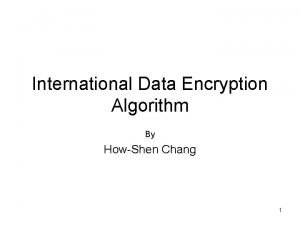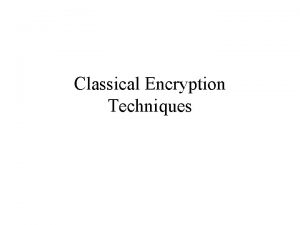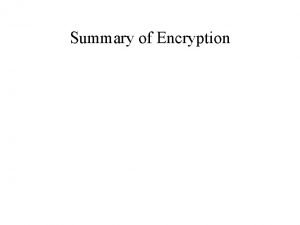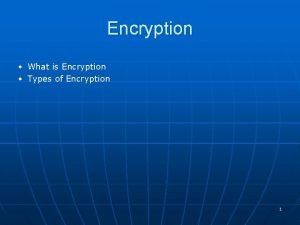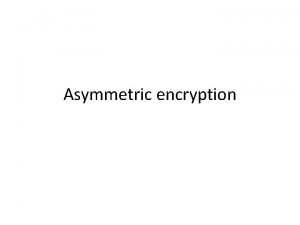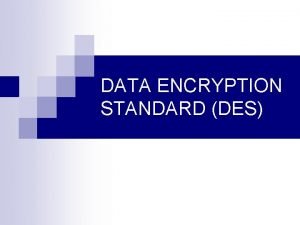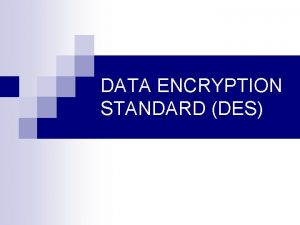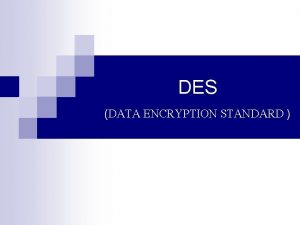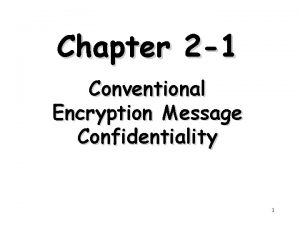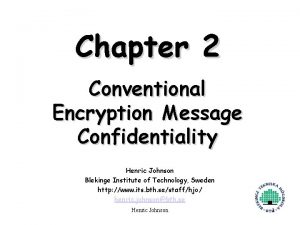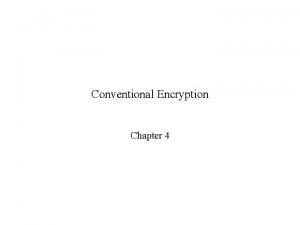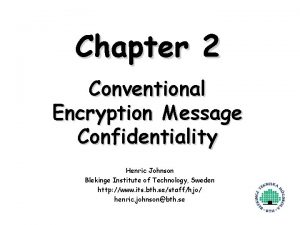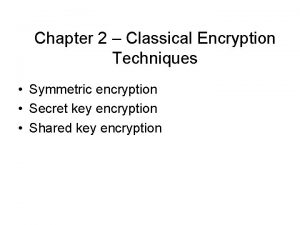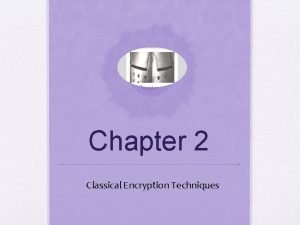Chapter 2 Conventional Encryption 1 Outline Conventional Encryption



























































- Slides: 59

Chapter 2 Conventional Encryption 1

Outline • • • Conventional Encryption Principles Conventional Encryption Algorithms Cipher Block Modes of Operation Location of Encryption Devices Key Distribution 2

Symmetric Encryption • A. k. a. conventional / secret-key / single-key • Sender and recipient share a common key • All classical encryption algorithms are secretkey-based • Was the only type prior to the invention of public-key in 1970’s • By far most widely used 3

Conventional Encryption Principles • An encryption scheme has five ingredients: – – – Plaintext Encryption algorithm Secret key Ciphertext Decryption algorithm • Security depends on the secrecy of the key, not the secrecy of the algorithm – Why? 4

Some Basic Terminology • Cipher – Algorithm for transforming plaintext to ciphertext • Encipher (encrypt) – Converting plaintext to ciphertext • Decipher (decrypt) – Recovering ciphertext from plaintext • Cryptography – Study of encryption principles/methods • Cryptanalysis (codebreaking) – Study of principles/ methods of deciphering ciphertext without knowing key • Cryptology – Field of both cryptography and cryptanalysis 5

Conventional Encryption Principles 6

Requirements • Two requirements for secure use of symmetric encryption: – A strong encryption algorithm – A secret key known only to sender and receiver • Mathematically we have: Y = EK(X) X = DK(Y) • Assume encryption algorithm is known • Implies a secure channel to distribute key 7

Cryptography • Characterize cryptographic systems by: – Type of encryption operations used • Substitution / transposition / product – Some examples will be discussed later – Number of keys used • Single-key or secret / two-key or public – Way in which plaintext is processed • Block / stream 8

Cryptanalysis • Objective – Recover key not just message • General approaches: – Cryptanalytic attack – Brute-force attack 9

Cryptanalytic Attacks • Ciphertext only – Only know algorithm & ciphertext, is statistical, know or can identify plaintext • Known plaintext – Know/suspect plaintext & ciphertext • Chosen plaintext – Select plaintext and obtain ciphertext • Chosen ciphertext – Select ciphertext and obtain plaintext • Chosen text – Select plaintext or ciphertext to en/decrypt 10

More Definitions • Unconditional security – No matter how much computer power or time is available, the cipher cannot be broken since the ciphertext provides insufficient information to uniquely determine the corresponding plaintext • Computational security – Given limited computing resources (e. g. time needed for calculations is greater than the age of universe), the cipher cannot be broken 11

Brute Force Search (Exhaustive Key Search) • Always possible to simply try every key • Most basic attack, proportional to key size • Assume either know / recognize plaintext Key Size (bits) Number of Alternative Keys Average time (1/2) Time required at 1 decryption/µs 106 decryptions/µs 32 232 = 4. 3 109 231 µs = 35. 8 minutes 2. 15 milliseconds 56 256 = 7. 2 1016 255 µs = 1142 years 10. 01 hours 128 2128 = 3. 4 1038 2127 µs = 5. 4 1024 years 5. 4 1018 years 168 2168 = 3. 7 1050 2167 µs = 5. 9 1036 years 5. 9 1030 years 26! = 4 1026 2 1026 µs = 6. 4 1012 years 26 letters (permutation) 6. 4 106 years 12

Classical Substitution Ciphers • Letters of plaintext are replaced by other letters or numbers or symbols – A popular TV show? • If plaintext is viewed as a sequence of bits, then substitution involves replacing plaintext bit patterns with ciphertext bit patterns • Let’s take a look at several real schemes… 13

Caesar Cipher • Earliest known substitution cipher – By Julius Caesar • First attested use in military affairs • Replaces each letter by the 3 rd letter following • Example: meet me after the toga party PHHW PH DIWHU WKH WRJD SDUWB 14

Caesar Cipher • Define transformation (mapping scheme) as: abcdefghijklmnopqrstuvwxyz DEFGHIJKLMNOPQRSTUVWXYZABC • Assign each letter a number abcdefghij k l m n o p q r s t u v w x y z 0 1 2 3 4 5 6 7 8 9 10 11 12 13 14 15 16 17 18 19 20 21 22 23 24 25 • Mathematical form of Caesar cipher: c = E(p) = (p + k) mod (26) p = D(c) = (c – k) mod (26) One mapping scheme one key/cipher How many possible keys/ciphers are there? 15

Cryptanalysis of Caesar Cipher • Only have 26 possible ciphers – Map A to A, B, …, or Z • Could simply try each in turn • A brute force search – Given ciphertext, just try all shifts of letters – Need to recognize when have plaintext • e. g. break ciphertext “GCUA VQ DTGCM” • One student works on one cipher each 16

Monoalphabetic Cipher • Rather than just shifting the alphabet • Could shuffle (jumble) the letters arbitrarily • Each plaintext letter maps to a different random ciphertext letter • Hence key is 26 letters long Plain: a b c d e f g h i j k l m n o p q r s tuvwxyz Cipher: D K V Q F I B J W P E S C X H T M Y A U OLRGZN Plaintext: ifwewishtoreplaceletters Ciphertext: WIRFRWAJUHYFTSDVFSFUUFYA • How many possible keys in total? 17

Monoalphabetic Cipher Security • • A total of 26! = 4^1026 keys With so many keys, one might think it is secure But would be !!!WRONG!!! Problem is language characteristics 18

Language Redundancy and Cryptanalysis • Human languages are redundant – e. g. "th lrd s m shphrd shll nt wnt" • Letters are not equally commonly used • In English – – E is by far the most common letter Followed by T, R, N, I, O, A, S Other letters like Z, J, K, Q, X are fairly rare Which set of characters are most commonly used in Chinese? • Have tables of single, double & triple letter frequencies for various languages 19

English Letter Frequencies 20

Use in Cryptanalysis • Key concept – Monoalphabetic substitution ciphers do not change relative letter frequencies – Discovered by Arabian scientists in 9 th century – Calculate letter frequencies for ciphertext – Compare counts/plots against known values • Caesar cipher looks for common peaks/troughs – Peaks at: A-E-I triple, NO pair, RST triple – Troughs at: JK, X-Z • Monoalphabetic must identify each letter – Tables of common double/triple letters help 21

Example Cryptanalysis • Given ciphertext: UZQSOVUOHXMOPVGPOZPEVSGZWSZOPFPESXUDBMETSXAIZ VUEPHZHMDZSHZOWSFPAPPDTSVPQUZWYMXUZUHSX EPYEPOPDZSZUFPOMBZWPFUPZHMDJUDTMOHMQ • Count relative letter frequencies (see text) – Guess which two individual letters are for e & t (with the highest frequencies)? • P&Z – Guess what “ZW” is for? • “th” and hence “ZWP” is “the” – Proceed with trial and error finally get: it was disclosed yesterday that several informal but direct contacts have been made with political representatives of the viet cong in moscow 22

Many other substitution methods… • • Playfair Cipher Polyalphabetic Ciphers Vigenère Cipher Aids Kasiski Method Autokey Cipher One-Time Pad 23

Transposition Ciphers • Now consider classical transposition or permutation ciphers • These hide the message – By rearranging the letter order – Without altering the actual letters used • Does the cipher text have the same frequency distribution as the original text? • Is it subject to the language frequency cryptanalysis? 24

Rail Fence Cipher • Write message letters out diagonally over a number of rows • Then read off cipher row by row – E. g. write message out as: m e m a t r h t g p r y e t e f e t e o a a t • Giving ciphertext MEMATRHTGPRY ETEFETEOAAT 25

Row Transposition Ciphers • A more complex transposition • Write letters of message out in rows over a specified number of columns • Then reorder the columns according to some key before reading off the rows Key: 3 4 2 1 5 6 7 Plaintext: a t t a c k p o column, s t p o n e Read starting from the 3 rd then the 4 th one, and sod on. u n t i l t w o a m x y z Ciphertext: TTNAAPTMTSUOAODWCOIXKNLYPETZ Method (algorithm) is not a secret, but key is the key! 26

Product Ciphers (Hybrid Scheme) • Ciphers using substitutions or transpositions are not secure because of language characteristics • Hence consider using several ciphers in succession to make harder, but: – Two substitutions make a more complex substitution – Two transpositions make a more complex transposition – But a substitution followed by a transposition makes a new much harder cipher • This is the bridge from classical to modern ciphers! 27

Rotor Machines • Before modern ciphers, rotor machines were most common complex ciphers in use • Widely used in WW 2 – German Enigma, Allied Hagelin, Japanese Purple • Implemented a very complex, varying substitution cipher • Used a series of cylinders, each giving one substitution, which rotated and changed after each letter was encrypted • With 3 cylinders have 263=17576 alphabets 28

Hagelin Rotor Machine 29

Steganography (藏头/尾诗) • An alternative to encryption • Hides existence of message – Using only a subset of letters/words in a longer message marked in some way – Using invisible ink – Hiding in LSB in graphic image or sound file • Has drawbacks – High overhead to hide relatively few info bits 30

Classical Feistel Cipher Structure • By Horst Feistel of IBM in 1973 – Virtually all conventional block encryption algorithms (including DES) use this structure • The realization of a Feistel Network depends on – the choice of a number of parameters and design features 31

Feistel Cipher Structure • Block size – larger block sizes mean greater security • Key Size – larger key size means greater security • Number of rounds – multiple rounds offer increasing security • Subkey generation algorithm – greater complexity will lead to greater difficulty of cryptanalysis. • Fast software encryption/decryption – the speed of execution of the algorithm becomes a concern 32

33

Conventional Encryption Algorithms • Data Encryption Standard (DES) – The most widely used encryption scheme – The algorithm is reffered to as the Data Encryption Algorithm (DEA) – DES is a block cipher – The plaintext is processed in 64 -bit blocks – The key is 56 -bits in length (original version) 34

35

36

DES • Mathematically, the overall processing at each iteration: – Li = Ri-1 – Ri = Li-1 F(Ri-1, Ki) • Concerns about: – The algorithm and the key length (56 -bits) 37

Avalanche Effect • An important desirable property of encryption algorithm – A change of one input or key bit results in changing approx half output bits – Making attacks by guessing keys impossible • DES exhibits strong avalanche 38

Time to break a code (106 decryptions/µs) 39

Strength of DES – Key Size • 56 -bit keys have 256 = 7. 2 x 1016 values – Brute force search looks hard • Recent advances have shown possibilities – In 1997 on the Internet in a few months – In 1998 on dedicated h/w (EFF) in a few days – In 1999 above combined in 22 hrs! • Still must be able to recognize plaintext 40

Strength of DES – Analytic Attacks • Several analytic attacks utilizing some deep structure of the cipher – By gathering information about encryptions – Can eventually recover some/all of the sub-key bits – If necessary then exhaustively search for the rest • Statistical attacks – Differential cryptanalysis – Linear cryptanalysis – Related key attacks • Must now consider alternatives to DES 41

Alternatives to DES • A replacement for DES was needed – Have theoretical attacks that can break it – have demonstrated exhaustive key search attacks • A strengthened DES – Triple-DEA (Triple-DES) 42

Triple DEA • Use three keys and three executions of the DES algorithm (encrypt-decryptencrypt) C = EK 3[DK 2[EK 1[P]]] • • C = ciphertext P = Plaintext EK[X] = encryption of X using key K DK[Y] = decryption of Y using key K • Effective key length of 168 bits (3 x 56) 43

Triple DEA 44

Alternatives to DES • Triple-DES – Slow • Use small blocks • AES Cipher – Rijndael – Designed by Joan. Daemen and Vincent Rijmen in Belgium – Has 128/192/256 -bit keys, 128 -bit data – An iterative rather than feistel cipher • Processes data as block of 4 columns of 4 bytes • Operates on entire data block in every round 45

Block vs. Stream Ciphers • Block ciphers – Process messages in blocks, each of which is then en/decrypted – Like a substitution on very big characters • 64 -bits or more – Need a table of 2^64 entries for a 64 -bit block • Instead, create from smaller building blocks – Using the idea of a product cipher – Many current ciphers are block ciphers • A wide range of applications • Stream ciphers – Process messages a bit or byte at a time when en/decrypting 46

Ideal Block Cipher Expansion (E-table) Permutation (P-box) Substitution (S-box) 47

Substitution-Permutation (S-P) Ciphers • S-P: substitution-permutation – Two primitive cryptographic operations • Substitution (S-box) • Permutation (P-box) – Introduced by Claude Shannon in 1949 paper – Form the basis of modern block ciphers – Provide confusion & diffusion of message & key 48

Confusion and Diffusion • Cipher needs to completely obscure statistical properties of the original message – A one-time pad does this • More practically, Shannon suggested combining S & P elements to obtain: – Diffusion • Dissipates statistical structure of plaintext over bulk of ciphertext – Confusion • Makes relationship between ciphertext and key as complex as possible 49

Other Symmetric Block Ciphers • International Data Encryption Algorithm (IDEA) – 128 -bit key – Used in PGP • Blowfish – Easy to implement – High execution speed – Run in less than 5 K of memory 50

Other Symmetric Block Ciphers • RC 5 – Suitable for hardware and software – Fast, simple – Adaptable to processors of different word lengths – Variable number of rounds – Variable-length key – Low memory requirement – High security – Data-dependent rotations • Cast-128 – Key size from 40 to 128 bits – The round function differs from round to round 51

Cipher Block Chaining Modes of Operation • Cipher Block Chaining (CBC) Mode – The input to the encryption algorithm is the XOR of the current plaintext block and the preceding ciphertext block. – Repeating pattern of 64 -bits are not exposed 52

53

Location of Encryption Device • Link encryption: – A lot of encryption devices – High level of security – Decrypt each packet at every switch • End-to-end encryption – The source encrypts and the receiver decrypts – Payload encrypted – Header in the clear • High Security – Both link and end-to-end encryption are needed 54

55

Key Distribution 1. Physical delivery § § A key could be selected by A and physically delivered to B. A third party could select the key and physically deliver it to A and B. 2. Network transfer § § § If A and B have previously used a key, one party could transmit the new key to the other, encrypted using the old key. If A and B each has an encrypted connection to a third party C, C could deliver a key on the encrypted links to A and B. Diffie-Hellman key exchange 56

Session and Permanent Key • Session key: – Data encrypted with a one-time session key – At the conclusion of the session, the key is destroyed • Permanent key: – Used between entities for the purpose of distributing session keys 57

58

Recommended Reading • Scneier, B. Applied Cryptography, New York: Wiley, 1996 • Mel, H. X. Baker, D. Cryptography Decrypted. Addison Wesley, 2001 59
 Conventional encryption principles
Conventional encryption principles Conventional encryption and message confidentiality
Conventional encryption and message confidentiality Confidentiality with symmetric encryption
Confidentiality with symmetric encryption Conventional encryption
Conventional encryption Conventional encryption model
Conventional encryption model Sentence outline examples
Sentence outline examples Labelling theory
Labelling theory Romans outline by chapter
Romans outline by chapter Research proposal
Research proposal Give me liberty chapter 27 outline
Give me liberty chapter 27 outline Methodology chapter outline
Methodology chapter outline Chapter 38 a world without borders outline
Chapter 38 a world without borders outline Vbscript
Vbscript Hunger games discussion questions
Hunger games discussion questions Chapter 31 societies at crossroads outline
Chapter 31 societies at crossroads outline Ap world history chapter 28 outline
Ap world history chapter 28 outline Observation research method
Observation research method Chapter 1 outline
Chapter 1 outline Chapter 1 outline
Chapter 1 outline Chapter 30
Chapter 30 Chapter 2 outline
Chapter 2 outline Outline book of acts
Outline book of acts 24 chapter outline
24 chapter outline 24 chapter outline
24 chapter outline Apush chapter 16 conquering a continent outline
Apush chapter 16 conquering a continent outline Veracrypt traveler disk setup
Veracrypt traveler disk setup Homomorphic encryption standard
Homomorphic encryption standard Advantages of asymmetric encryption
Advantages of asymmetric encryption Placement of encryption function in cryptography
Placement of encryption function in cryptography Outlook 365
Outlook 365 Making good encryption algorithms
Making good encryption algorithms Lest we remember: cold boot attacks on encryption keys
Lest we remember: cold boot attacks on encryption keys Elgamal example
Elgamal example Public key encryption
Public key encryption Rsa algorithm in java
Rsa algorithm in java Encoding encryption and hashing
Encoding encryption and hashing Encryption decrypti
Encryption decrypti Crc encryption
Crc encryption Encryption
Encryption Homomorphic encryption tutorial
Homomorphic encryption tutorial Encryption wizard
Encryption wizard Encryption
Encryption Ibm cloud object storage replication
Ibm cloud object storage replication Honey encryption algorithm
Honey encryption algorithm Homomorphic encryption tutorial
Homomorphic encryption tutorial Hill cipher decryption code
Hill cipher decryption code Symmetric encryption java
Symmetric encryption java Craig gentry homomorphic encryption
Craig gentry homomorphic encryption Encryption levels
Encryption levels Elgamal encryption calculator
Elgamal encryption calculator Classical encryption techniques in network security
Classical encryption techniques in network security Barracuda ess
Barracuda ess Aes des
Aes des Rc lucifer
Rc lucifer What is encryption
What is encryption Number theory encryption
Number theory encryption Modern block cipher in cryptography
Modern block cipher in cryptography Pkix architectural model
Pkix architectural model Bank encryption standards
Bank encryption standards International data encryption algorithm
International data encryption algorithm
